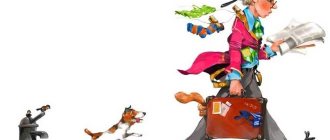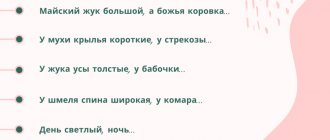Pedagogical project in the senior speech therapy group “Clothing. What? For what? Of what?"
Natalya Zhmaeva
Pedagogical project in the senior speech therapy group “Clothing. What? For what? Of what?"
Relevance. The project allows you to expand children's horizons, enrich and systematize children's knowledge on the lexical topic " Clothing "
.
By expanding the horizons of children, the project helps to facilitate the process of cognition, activate the thinking process, cognitive activity, and creative abilities.
Objective of the project :
Expanding and systematizing knowledge about clothing and its purpose .
1. Formation in children of interest and ideas about the variety of clothing and its purpose .
2. Familiarity with the variety of fabrics, their purpose and application.
3. Getting to know the professions of people related to clothing .
4. Activation and enrichment of children’s vocabulary on a given lexical topic, the formation of grammatically correct speech.
Integration with other educational areas:
Speech development, Social and communicative development, Cognitive development, Artistic and aesthetic development, Physical development.
Communicative, productive, gaming, labor, motor, reading fiction, musical and artistic.
Project stages :
1. Organizational stage.
2. Productive stage.
Participants of this project : children of the ONR group , their parents, teachers .
Project duration : 1 week.
The effectiveness of this project :
1. Expansion and systematization of children’s knowledge about fabrics, clothing , professions (weaver, tailor, seamstress, fashion designer)
.
2. Solving problems on the formation of grammatically correct structure of speech, the development of coherent speech, and the enrichment of vocabulary.
3. Replenishment of the development environment in the game center (production of attributes for the role-playing game “Atelier”)
4. Making albums for the center of cognitive development: “World of Fabrics”.
5. Exhibition of children's works within the framework of the project : “Young Fashion Designer”.
6. Involving parents to participate in the group’s project activities .
Working with parents
Invite the parents of the group to participate in the project - ask them to bring scraps of various fabrics to make the album “The World of Fabrics”.
Final stage of the project :
Exhibition of children's works "Young Fashion Designer".
Project type :
1. Word game “Guess”
.
Goal: To teach children to guess an item of clothing by the name of its parts.
2. Printed board game “Pick up a patch”
.
Goal: To learn to correlate the color pattern and the shape of the “patch”
and
"fabrics"
.
3. Cognitive, research and constructive activities. Topic: clothes appeared ”
.
Objectives: To cultivate respect for people in the garment industry. Develop attention, memory, thinking, speech. Expand and activate children's vocabulary: seamstress, tailor, fashion designer, cutter, atelier, thimble, garment factory. To form children’s ideas about clothing production in the modern world, about professions in the clothing industry.
4. Musical educational activities.
Singing the Russian folk song "Spinning"
processed by T. Lomova.
Russian folk dance "Lyon"
arranged by Rauchwerger.
5.Work with parents: offer to make a cardboard doll together with the children (for girls - a girl doll, for boys - a boy doll)
and 2-3 pieces
of paper clothing for her .
Goal: To involve parents in the educational process in preschool educational institutions on the topic “ Clothing ”
.
Goal: Work on general speech skills: intonation expressiveness of speech, clear sound pronunciation.
2. Reading the work of N. Nosov “Patch”
, conversation based on reading.
Objectives: To foster independence, hard work, and careful handling of clothing . Develop attention, memory, speech. Develop the ability to answer the teacher’s questions about the work read. Teach children to highlight the main idea of the story and characterize the actions of the main character.
3. Examination of scraps of fabric.
Goal: To introduce children to different types of fabrics and their names (chintz, nylon, fur, flannel, silk.)
4. Speech development. Topic: Riddles, proverbs and sayings about clothes .
Objectives: To cultivate a love for Russian folklore. Develop attention, memory, speech. Continue to teach children to solve riddles and understand the allegorical meaning of riddles. Introduce children to proverbs and sayings about clothing and their meaning.
5. Modeling. Theme: Girl in a beautiful dress.
Objectives: Strengthen sculpting skills: rolling, unrolling, flattening, smoothing, connecting parts. Develop creative abilities. Teach children to sculpt the figure of a girl in a dress, based on a sample and a diagram of the sculpting sequence. Teach children to apply a pattern on a dress according to their own design.
1. Reviewing clothing models in fashion magazines .
Goal: To form children’s ideas about the variety of clothing .
2. Conversation on the topic “ Clothing of the future ”
Objectives: To cultivate respect for the answers of comrades. Develop imagination, speech, logical thinking.
3. Development of elementary mathematical concepts.
Topic: Clothes .
Objectives: To develop quantitative counting skills within ten. Develop mental and speech activity, coordination of speech with movement, fine motor skills, and speech hearing. Develop children's ability to add numbers by solving simple math problems. Foster activity, initiative, independence, and cooperation skills.
4. Drawing in an unconventional way (batik)
.Theme: Magic patterns.
Objectives: To develop children's sustainable interest in drawing in unconventional ways. To form a personal position in children in the creative process.
Develop imagination, creativity, imagination. Enrich your vocabulary.
5. Didactic game “Find out by touch”
.
Goal: To teach children to identify by touch and name some types of fabrics (fur, flannel, nylon, silk, leather, drape, corduroy, etc.)
1. Didactic game “Find out by description”
.
Goal: To teach children to recognize peers by description of appearance ( clothing , eye color, hair)
.
2. Low mobility game “Where we were, we won’t say...”
Purpose: To teach children to expressively depict various actions (washing clothes , sewing, dressing, etc.)
3. Speech development. Topic: Tailor.
Objectives: To develop respect for the answers of peers. Develop attention, memory, logical thinking, speech. Teach children retelling, based on the teacher’s retelling model and the retelling scheme. Teach children to use complex and common sentences in speech.
4. Exercise “Look and name”
Goal: Improve the grammatical structure of speech, teach the use of nouns according to the tama “ Clothing ”
in singular and plural form.
5. Reading V. Livshits “Valina’s Gloves”
.
Objectives: To cultivate neatness and careful handling of clothing . Develop attention, memory, speech. Learn to understand the instructive meaning of the poem.
1. Organizing an exhibition of flat dolls in paper outfits created by children and parents.
Goal: To recognize the efforts and responsiveness of all exhibitors and to reward the winners.
2. Game “Recognize the doll by description”
.
Goal: To teach children to make a wish for a certain doll, describing its appearance: clothes , hair color, eyes.
Topic: New dress for a doll.
Objectives: To develop careful handling of scissors and accuracy when working with glue. Develop symmetrical cutting skills from a sheet of paper folded in half. Develop creativity and imagination. Teach children to cut out the shape of a dress using the symmetrical cutting method, and decorate the dress with a pattern according to their design.
4. Game “Riddles in a bag”
.
Goal: To teach children to guess riddles about the tools of the clothing industry, to find a picture from a bag that corresponds to the answer.
5. Training game “Needle and thread”
Goal: To foster a sense of cohesion and collectivism. Teach children to gradually join the game, joining the latter in the “thread”
.
Teach children to play the role of a leader - a “needle”
.
1. Arushanova A. G. Speech and verbal communication of children: A book for kindergarten teachers. – M. 1999
2. Komarova T. S., Zaryanova O. Yu., Ivanova L. I., Karzina G. I., Milova O. M. Fine art of children in kindergarten and school. – M. 2000
4. Nishcheva N.V., System of correctional work in a speech therapy group for children with general speech underdevelopment. St. Petersburg, “Childhood-press”
, 2009.
5. Think of a word: speech games and exercises for preschoolers (O. S. Ushakova, A. G. Arushanova, E. M. Strunina and others - M., 1996.
6. 365 educational games (compiled by Belyakov E. A. - M. 2010.
7. Correction of speech and movement with musical accompaniment. O. S. Boromykova (ed. “Childhood-press”
)
8. Amazing stories. L. E. Belousova (St. Petersburg “Childhood-press”
2000).
9. Final days on lexical topics. Planning and notes. Book 1. E. A. Alyabyeva
(Creative center SPHERE. M. – 2007)
10. Professions. What are they like, M. 2014.
Summary of an integrated lesson on speech development in a speech therapy group. Topic: “Clothes, hats, shoes” Goals: to consolidate the generalized concept of “clothing”, to learn to differentiate clothes by season, to learn to compose a coherent story about any subject.
Summary of GCD in the senior group “Special clothing, who needs it and why” GCD in the senior group. Cognition. “Special clothing, who needs it and why.” Program objectives: Expand children's understanding of functions.
Source


